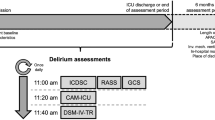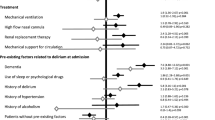Abstract
Introduction: Until now, there has been no gold standard for monitoring delirium in intensive care unit (ICU) patients. In this prospective cohort study, a new score, the Delirium Detection Score (DDS), for severity of delirium in the ICU was evaluated.
Methods: After ethical approval and written informed consent, intensive care doctors and nurses assessed 1073 consecutive patients in surgical ICUs using the DDS together with the Ramsay Sedation Scale (RSS). The DDS is composed of eight criteria (orientation, hallucination, agitation, anxiety, seizures, tremor, paroxysmal sweating, and altered sleepwake rhythm). Additionally, intensive care doctors had to document the Sedation-Agitation Scale (SAS) combined with a defined clinical assessment. For interrater reliability, pair of evaluators assessed patients in a blinded fashion at the same time.
Results: RSS1 (9%) was associated with a significantly (p<0.001) higher DDS than RSS levels 2–6. The DDS increased with the severity of delirium (p< 0.001). The receiver operating characteristics (ROC) for the differentiation between no delirium (SAS<4) and symptoms of delirium at all (SAS 5–7) showed an area under the curve (AUC) of 0.802 (95% confidential interval (CI): 0.719–0.898; p<0.001) and 69% sensitivity and 75% specificity was determined. For reliability, a Cronbach’s α of 0.667 was calculated. The paired comparisons revealed an intraclass correlation between 0.642 and 0.758.
Conclusion: The DDS demonstrated good validity with excellent sensitivity and specificity for delirium. The severity of delirium can be more accurately estimated by the DDS. By its composition of several items, the DDS might help to start a symptom-guided therapy immediately.
Similar content being viewed by others
References
The management of the agitated ICU patient. Crit Care Med 2002;30(Suppl 1):S97–S123.
American Psychiatric Association. Diagnostic and Statistical Manual of Mental Disorders, 4th ed, Washington, DC, 1994.
Ely EW, Margolin R, Francis J, et al. Evaluation of delirium in critically ill patients: Validation of the Confusion Assessment Method for the Intensive Care Unit (CAM-ICU). Crit Care Med 2001;29:1370–1379.
Sullivan JT, Sykora K, Schneiderman J, Naranjo CA, Sellers EM. Assessment of alcohol withdrawal: The revised clinical institute withdrawal assessment for alcohol scale (CIWA-Ar). Br J Addict 1989;84:1353–1357.
Handelsman L, Cochrane KJ, Aronson MJ, Ness R, Rubinstein KJ, Kanof PD. Two new rating scales for opiate withdrawal. Am J Drug Alcohol Abuse 1987;13:293–308.
Ramsay MA, Savege TM, Simpson BR, Goodwin R. Controlled sedation with Alphaxalone-Alphadolone. Br Med J 1974;2:656–659.
Riker RR, Picard JT, Fraser GL. Prospective evaluation of the Sedation-Agitation Scale for adult critically ill patients. Crit Care Med 1999;27:1325–1329.
Hansen-Flaschen J, Cowen J, Polomano RC. Beyond the Ramsay Scale: Need for a validated measure of sedating drug efficacy in the intensive care unit. Crit Care Med 1994;22:732–733.
Knaus WA, Draper EA, Wagner DP, Zimmerman JE. APACHE II: A severity of disease classification system. Crit Care Med 1985;13:818–829.
Garner JS, Jarvis WR, Emori TG, Horan TC, Hughes JM. CDC definitions for nosocomial infections. Am J Infect Control 1988;16:128–140.
Eggers V, Schilling A, Kox WJ, Spies C. Septische Enzephalopathy. Differential diagnose und therapeutische Einflussmöglichkeiten. Anaesthesist 2003;52:294–303.
Rasch D. Elementare Einführung in die mathematische Statistik. Berlin, VEB Deutscher Verlag der Wissenschaften, 1968.
Holm S. A simple sequentially rejective multiple test procedure. Scand J Stat 1979;6:65–70.
Ely EW, Truman B, Shintani A, et al. Sedation status over time in ICU patients. Reliability and validity of the Richmond Agitation-Sedation Scale (RASS). JAMA 2003;289:2983–2991.
Triltsch AE, Welte M, von Homeyer P, et al. Bispectral index-guided sedation with dexmedetomidine in intensive care: A prospective, randomized, double blind, placebo-controlled phase II study. Crit Care Med 2002;30:1007–1014.
Moshirzadeh M, Beesk D, Spies C. The influence of clonidine on bispectral index-guided sedation after cardiac surgery. Intensive Care Med 2002;28(Suppl 1):S180.
Spies CD, Dubisz N, Funk W, et al. Prophylaxis of alcohol withdrawal syndrome in alcohol-dependent patients admitted to the intensive care unit after tumour resection. Br J Anaesth 1995;75:734–739.
Spies CD, Dubisz N, Neumann T, et al. Therapy of alcohol withdrawal syndrome in intensive care unit patients following trauma: Results of a prospective, randomized trial. Crit Care Med 1996;24:414–422 [Review].
Spies CD, Rommelspacher H. Alcohol withdrawal in the surgical patient: Prevention and treatment. Anesth Analg 1999;88:946–954 [Review].
Otter H, Spies C. Analogsedierung und Entzugssyndrom. In W Kox, C Spies, eds. Check-up Anästhesiologie Standards Anästhesie — Intensivmedizin — Schmerztherapie — Notfallmedizin, 1st ed. Berlin: Springer, 2003:370–378.
Ely EW, Gautam S, Margolin R, et al. The impact of delirium in the intensive care unit on hospital length of stay. Intensive Care Med 2001;27:1892–1900.
Spies CD, Otter HE, Huske B, et al. Alcohol withdrawal severity is decreased by symptom-orientated adjusted bolus therapy in the ICU. Intensive Care Med 2003;29:2230–2238.
Barr J, Zomorodi K, Bertaccini EJ, Shafer SL, Geller E. A double-blind, randomized comparison of IV Lorazepam versus Midazolam for sedation of ICU patients via a pharmcological model. Anesthesiology 2001;95:286–298.
Jacobi J, Fraser GL, Coursin DB, et al. Clinical practice guidelines for the sustained use of sedatives and analgesics in the critically ill adult. Crit Care Med 2002;30:119–141.
Fraser GL, Riker RR. Monitoring sedation, agitation, analgesia, and delirium in critically ill adult patients. Crit Care Clin 2001;17:967–987 [Review].
Biffle WL, Harrington DT, Cioffi WG. Implementation of a tertiary trauma survey decreases missed injuries. J Trauma 2003;54:38–43.
Ruchholtz S, Waydhas C, Lewan U, et al. A multidisciplinary quality management system for the early treatment of severely injured patients: Implementation and results in two trauma centers. Intensive Care Med 2002;28:1395–1404.
Mascia MF, Koch M, Medicis JJ. Pharmacoeconomic impact of rational use guidelines on the provision of analgesia, sedation, and neuromuscular blockade in critical care. Crit Care Med 2000;28:2300–2306.
Author information
Authors and Affiliations
Corresponding author
Rights and permissions
About this article
Cite this article
Otter, H., Martin, J., Bäsell, K. et al. Validity and reliability of the DDS for severity of delirium in the ICU. Neurocrit Care 2, 150–158 (2005). https://doi.org/10.1385/NCC:2:2:150
Issue Date:
DOI: https://doi.org/10.1385/NCC:2:2:150




